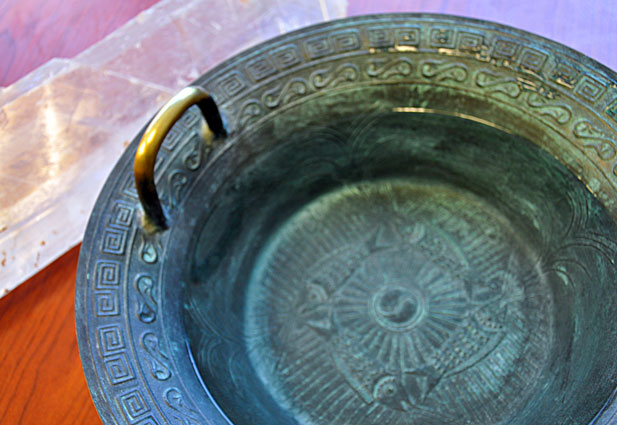
Spouting Water Bowl
Summary
This bowl, filled with water, shows the properties of resonance by using friction to create vibration throughout the rim of the bowl. IMPORTANT!!! Under no circumstances should an unsupervised minor perform the procedures described herein. All the following described experiments and methods should be supervised by an adult who is completely familiar with and takes full responsibility for all possible hazards.
General Information
Essential Questions
- What is a wave?
- How are waves created?
- What is interference?
Bibliography
- Lockhart, E., Young, C., Butterfield, A.E., Water Bowl Classroom Demonstration. https://www.che.utah.edu/community_and_outreach/modules/module.php?p_id=17
Materials & Methods
- Resonating Water Bowl
- Enough Water to Fill the Bowl
- Paper Towels
Background for Teachers
We encounter waves every day. There are many types of waves varying from sound to light waves. The Water Bowl allows students to gain an unique perspective on wave propagation. Wave propagation is the transmission of waves through a substance.
Students are able to see the constructive and destructive waves interact with each other as they watch the water jump away from the bowl in some spots and lay almost still in others. Where there are constructive waves the water jumps. This is because the waves are in sync with each other causing an increase in amplitude.
Where there are destructive waves the water is practically still. The reason for this is due to the waves hitting each other at just the right frequency so they cancel each other out.
The unique geometry of this bowl is why the waves propagate. Where there are grooves on four spots of the bowl is where we see an occurrence of constructive waves. Where there bowl shows no grooves is where we see the destructive waves. It is also important to note the center of the bowl. The center of the bowl gets the least amount of vibrations. This is due to the distance it is from the sides of the bowl. The vibrations have to travel farther, therefore they are not as strong.
Another unique theory involved with the Water Bowl is resonance. Resonance is defined as the condition in which an object or system is subjected to an oscillating force having a frequency close to its own natural frequency. To simplify this definition, look to the example of the singing glass.
In the singing glass example, you place pressure on the rim of a glass that is half full of water. As you make a circular motion, you see vibrations from the water and you also hear a ringing sound. This ringing sound is created from the waves disturbing the air inside the cup. Resonance is achieved in the singing glass because we took an motionless object and applied force or pressure to create vibrations and waves.
Resonance is an advanced theory. Many students are prone to thinking it is something they have to see or something applied. However, we do not apply resonance, we apply force or pressure to achieve resonance. Resonance is a state at which most objects are not naturally in. Outside forces have to exert energy to make an object reach resonance. Resonance would be achieved if your objects or substances reached a state of vibrational or wave like behavior.
Below you will find a video of one of the most striking examples of resonance. The Tacoma Narrows Bridge was built in Washington in 1940. On November 7, 1940 terror struck all that were near or on the bridge. It was a particularly windy day and this force caused resonance with the bridge leading to its collapse.
Videos
Array
Instructional Procedures
- Fill up the Water Bowl.
- Lightly place your hands on the surface of the water allowing your palms to be slightly moist.
- Place hands on the handles of the bowl and create a forward-backward motion.
- It is important to apply enough pressure but remember too much will disrupt the vibrations.
- Enjoy the Water Bowl!